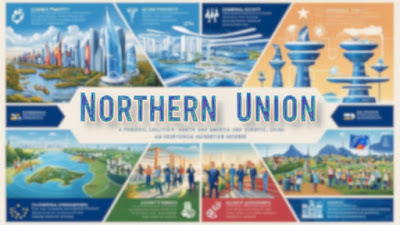Globalization – »The Northern Union« – A New and Refreshing Initiative
The concept of globalization has taken many forms throughout history, but none have fully realized the potential of a unified political and economic entity spanning the developed nations of the Northern Hemisphere. The idea of "The Northern Union"—a coalition of North America and Europe—represents an ambitious experiment in globalization, where economic prosperity, technological advancement, and geopolitical stability could reach unprecedented heights. However, such a union would also require strict adherence to regulations and shared values to function effectively.
In 2024, sea levels rose faster than anticipated, with regions like Hawaii experiencing accelerated subsidence, leading to earlier-than-expected flooding. Similarly, coastal cities in California, including San Francisco and Los Angeles, faced rapid land sinking, compounding the effects of rising sea levels.
The Rationale for a Northern Union
At its core, The Northern Union would integrate the United States, Canada, and the European Union into a single economic and political framework. These regions already share strong cultural and historical ties, trade agreements, and security alliances such as NATO. By formalizing this relationship into a singular entity, The Northern Union could:
- Enhance Economic Growth – A consolidated market encompassing the world's largest economies would drive innovation, facilitate free trade, and reduce economic disparities among member states.
- Strengthen Global Influence – In an era where economic power is shifting eastward, The Northern Union would maintain leadership in global decision-making, upholding democratic values and human rights.
- Coordinate Climate Action – The combined resources of the Northern Hemisphere could spearhead climate initiatives, ensuring environmental policies are standardized and enforced at a global level.
- Boost Scientific and Technological Advancements – A unified research and development sector would enable rapid progress in AI, healthcare, space exploration, and other cutting-edge industries.
Challenges and Strict Regulations
According to reports from organizations like the WMO and NASA, 2024 has been confirmed as the warmest year on record, with global average temperatures exceeding 1.5°C above pre-industrial levels. This unprecedented heat surge, intensified by factors like El Niño and rising greenhouse gas emissions, has resulted in a year of record-breaking temperatures and extreme weather events.
A project of this magnitude would necessitate a strict framework of governance to prevent internal divisions and ensure compliance with collective goals. The Northern Union would need to establish:
- Political Integration – Unlike the EU, which operates on a mix of supranational and intergovernmental decision-making, The Northern Union would require a robust central governing body to align policies and regulations effectively.
- Economic Equity – Differences in economic models between the U.S., Canada, and the EU would require harmonization of tax policies, trade laws, and labor rights to prevent financial imbalances.
- Immigration and Border Policies – With freedom of movement between continents, there would need to be a standardized approach to immigration, security, and asylum policies.
- Defense and Security Coordination – NATO already provides a security framework, but deeper military cooperation and intelligence sharing would be crucial to managing global threats.
New Members Welcome, but Rules Must Be Enforced
While The Northern Union is initially envisioned as a coalition of North America and Europe, other nations, including Russia and China, would be welcome to join—provided they adhere to the strict regulations and shared governance principles of the Union. This inclusion could foster greater global cooperation and reduce geopolitical tensions, but only if all members commit to upholding democratic values, economic transparency, and security agreements.
Would It Be Feasible?
The idea of The Northern Union, while visionary, faces significant political and ideological hurdles. National identities remain strong, and the resistance to surrendering sovereignty to a higher governing body would likely be intense. However, in a world facing rapid technological changes, economic shifts, and climate crises, a stronger, more unified Northern Hemisphere could provide stability and leadership.
In the grand experiment of globalization, The Northern Union would be a bold step forward—one that requires commitment, discipline, and a collective vision for the future. The rules would be strict, but the rewards could redefine the global order. The question remains: are we ready to take this leap?

Comments
Post a Comment